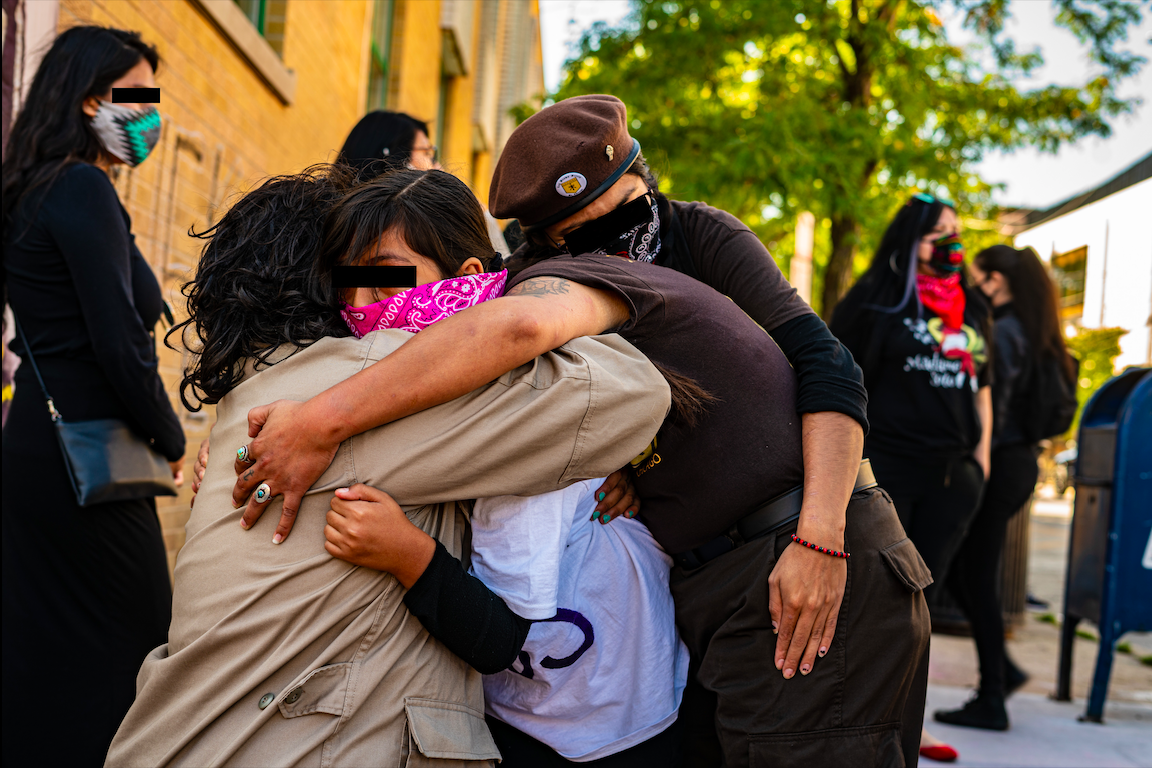CONTENT WARNING: Graphic depictions of violence; mentions of violence, sexual assault, gender-based violence.
Protesters and bystanders watched in horror on Saturday afternoon, September 19, as a small, nonviolent rally against femicide was attacked by Chicago police. Organizers said the violence felt like it was intended to silence freedom of speech.
A coalition of activists from various groups, including Femme Defensa, Black Rose/Rosa Negra, Chicago General Defense Committee, Little Village Solidarity Network, and Chi Resists, demonstrated at the Mexican Consulate at 204 S. Ashland Ave. in solidarity with ongoing protests in Mexico against rapidly rising rates of femicides and gender-based violence. They chose the consulate as a site to voice their message to the Mexican government.
On September 7 in Mexico City, the Ni Una Menos (Not One Woman Less) Collective occupied the headquarters of the National Human Rights Commission, turning it into a shelter for survivors of gender-based violence. Widespread political corruption, organized crime, and state indifference are all implicated in the high rates of unsolved rape and murder cases in Mexico. In 2020, an average of ten women there have been murdered every day. In August 2019, protests erupted when Mexican police were accused of raping two teens.
“There have been groups of feminists and mothers, women who have been disappeared, murdered, and raped in Mexico. They are occupying HR commissions in different cities, demanding an end to femicide,” explained Betty, an organizer with Chi Resists who asked that her last name not be published.
In Chicago on Saturday, organizers had planned to show their support for Mexican activists with speeches and community art projects at the consulate, and a “die-in” of women and femmes in the intersection of Ashland and Adams, two blocks north of the consulate and just outside of Union Park.
During the protest, the consulate appeared to be closed and at press time, they had not responded to requests for comment.
When demonstrators arrived to set up their art actions, police asked them whether the protest was going to be “peaceful” or not. Demonstrators also said they told them, “We control these streets.”
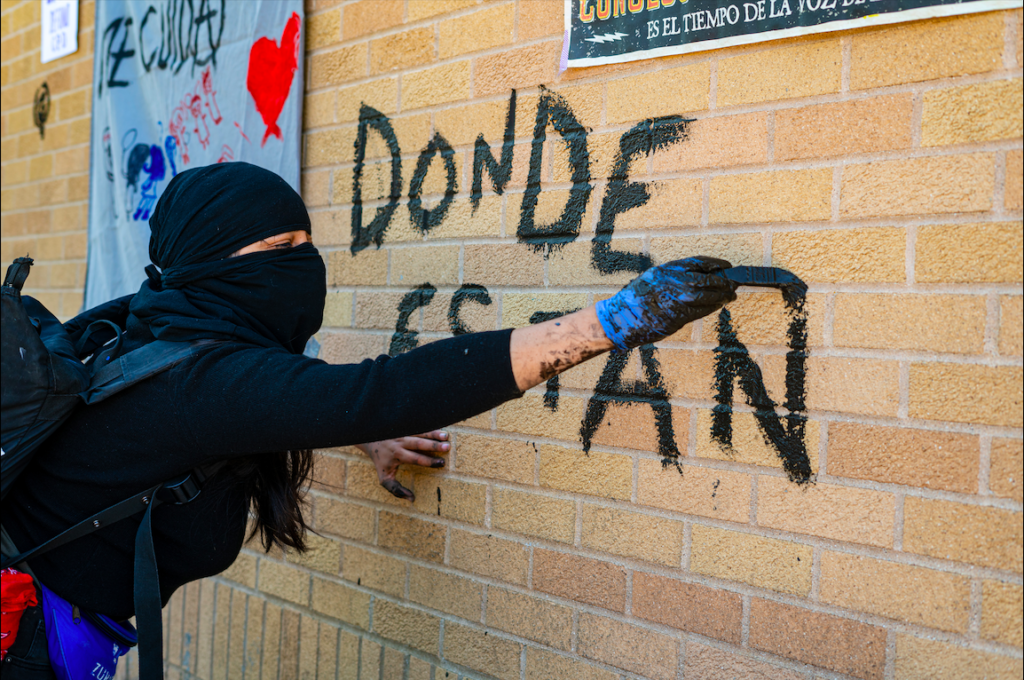
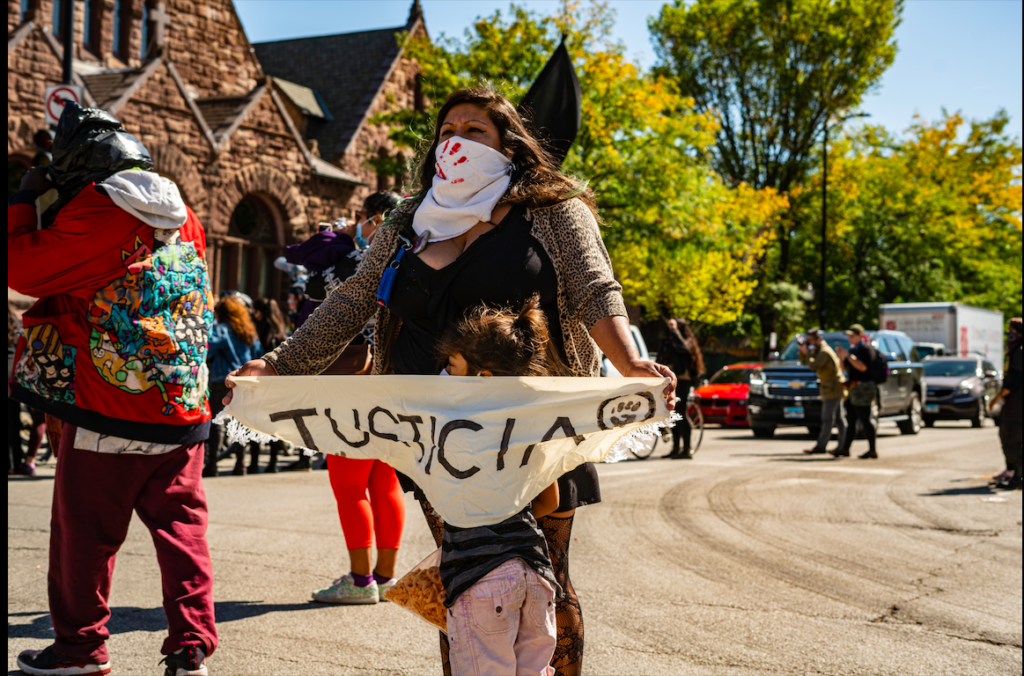
Organizers affixed banners and art to and painted slogans on the wall of the consulate. After circling the intersection, the activists stepped into garbage bags to represent Black and brown women murdered in Chicago whose cases remain unsolved.
Protesters also pointed to high rates of domestic violence among American police officers, as well as a lack of justice for sexual assault victims, as rape kits around the world remain untested at disappointing rates.
“We’re noticing these patterns in Mexico and in the U.S.,” said one supporting activist, who asked to be called Lily, a pseudonym. “These systems are white supremacy and patriarchal, they work hand in hand, and it doesn’t matter who works for the police. It’s a system that’s meant to dismiss neglect and not support femmes, gender non-binary people, and trans women.”
The activists never got a chance to start the die-in. More police arrived, and demanded the group move to the sidewalks instead. The action had been going for twenty minutes, and had not been planned to last much longer.
Officers used their bikes to force the group backward, hitting young women with their handlebars and wheels. Lily reported seeing someone reach for their inhaler after they had been struck in the chest, possibly experiencing an asthma attack.
“At a certain point I couldn’t move anymore because there were people behind me, and I was telling [the police officer] to please not push me,” Betty said.
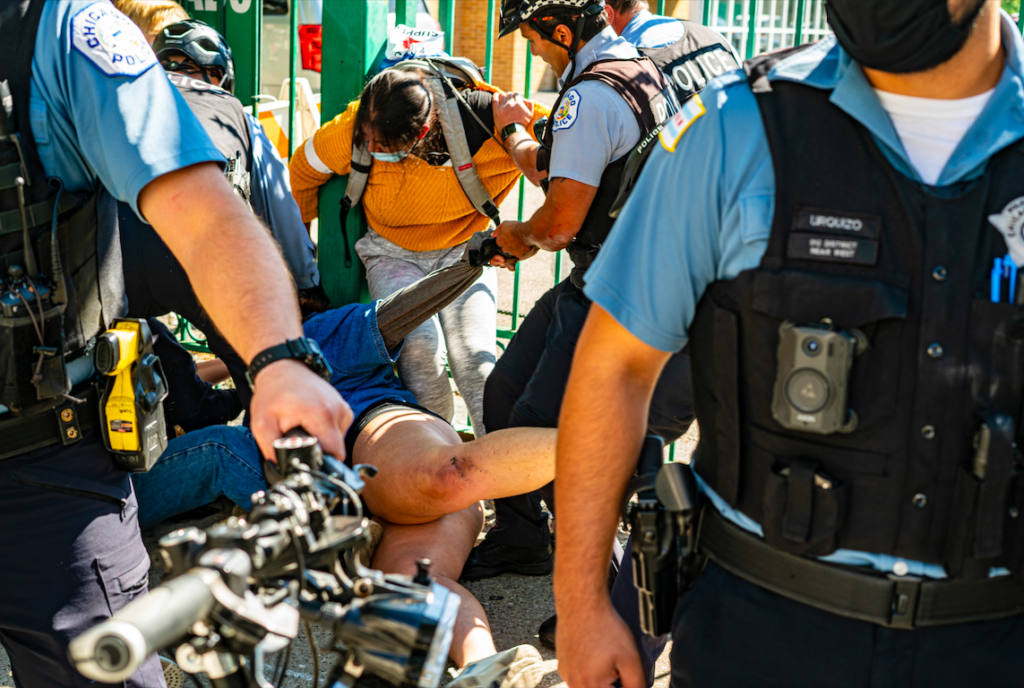
The action was over almost as quickly as it had begun.
As activists prepared to retreat, fearing for the safety of mothers and children in the crowd, police continued pushing them with their bikes.
“I see the cops immediately approaching the women who were holding the banner somewhere on the sidewalk,” Lily said. “And some of them rolled up to them really quickly and got in their space and they were, I swear you, inches from their faces, just telling them to get out, to move. And that’s just not a way to de-escalate.”
She witnessed police start swinging at protesters as they struggled over the banner at the northwest corner of the intersection. After that, the first chase broke out.
A statement issued by a CPD spokesperson said that protesters “became aggressive and began to fight with officers.”
The statement is inconsistent with eyewitness accounts from the scene. Demonstrators told the Weekly they felt their attempt at a peaceful event was immediately squashed, and that police instigated physical altercations—not the other way around.
“The police just rushed forward and were chasing a young person until they grabbed her. It was just a melee,” Betty said. She and other activists were shocked to see CPD respond so forcefully to such a small action, and one that included children. “I saw people getting punched and elbowed. I was physically pushed with a bike multiple times.”
Protesters told the Weekly that they were shoved unprovoked, grabbed, struck with batons, and hit with bicycles.
Police reported that two female officers were injured and treated at the scene by CFD, then released.
After pushing into the crowd, police cornered one group against the side of the consulate.
“They were twisting this girl’s arm, pushing her against a wall,” Lily said. “She’s wailing and crying, people are asking the officers, ‘why are you detaining them? Why are you detaining them?’”
Farther down the street, police cornered three femmes against a fence. Witnesses cried out, “Abuser! Domestic violence!” as they watched the all-male group of officers overpower the femmes, twisting and yanking one young protester’s limbs.
One activist’s dress had ridden up as the police grabbed them, exposing them to the public. Officers made no attempt to help.
Other officers chased a single protester down an alley. When they caught up, the police piled on top.
“We have been protesting in Pilsen and at the consulate for years and even generations before us,” Betty said. “We have never experienced this type of violence, and it’s really beginning to feel like it’s limiting our free speech.”
Her feelings are consistent with what others have reported since violent suppression of a youth-led protest in the Loop on August 15—an incident in which police assaulted protesters, unleashed a dangerous amount of pepper spray into a retreating crowd, and then chased and kettled the injured against the side of a building. Since that protest, many have expressed hesitation about demonstrating in the downtown area, which raises the question: when you fear the police too much to protest, are you really free to protest?
“They’re using this as a form of intimidation. Intimidation and fear to prevent people from using collective power,” Lily said.
The disruptive impact of any large action is vastly muted when forced out of the central business district, but even smaller community events are now seemingly being targeted for escalation.
One protester reported hearing an officer mutter, “We are tired of all of this” early on, just as the initial bike push began.
After police pulled those arrested into vans, they kept using their bikes to force people back again. On video, one officer can be seen aggressively striking an activist with his bike; another officer at his side puts a hand on his shoulder, telling him to “calm down.”
The shaken protesters retreated back to their starting point in front of the consulate. Along the way, police again shoved activists without apparent provocation, telling them to get moving.
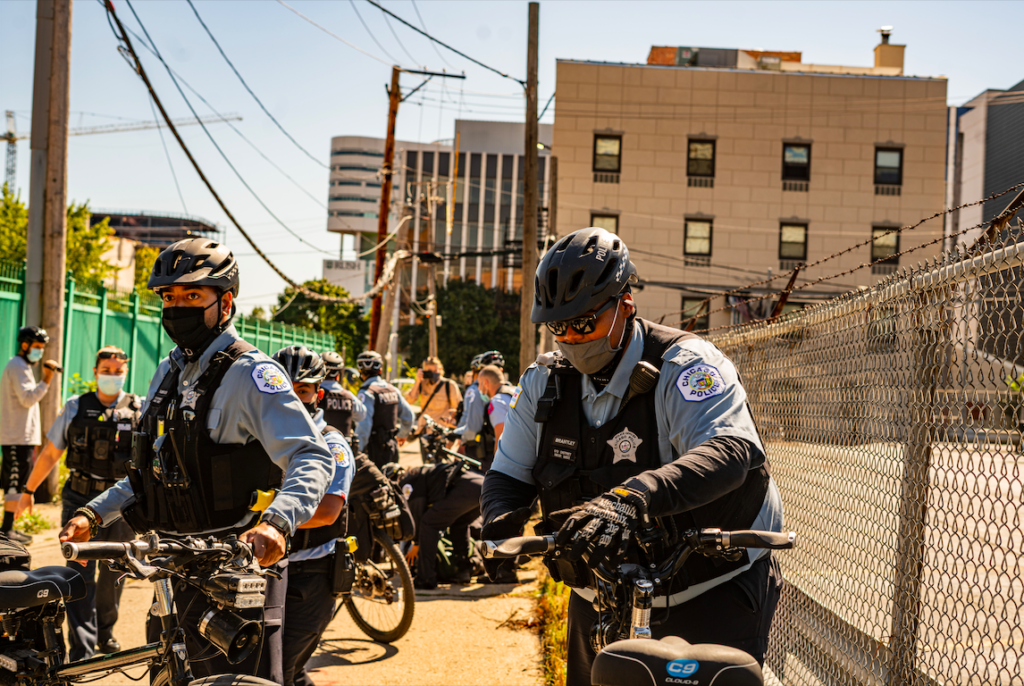
Three protesters were arrested Saturday afternoon, and spent two nights in jail.
Activists signed up for around-the-clock jail support shifts throughout the weekend. They passed out portable chargers, water, and croissants. As one speaker said at the rally on Saturday, “nosotros nos tenemos que cuidar, nadie nos va salvar” (“we have to take care of each other, no one can save us”).
Before their release on Monday, all three were charged with felony aggravated battery to a peace officer. Organizers are calling for the charges to be dropped, pointing to the pattern of police escalation and aggression they experienced that day.
“It’s just unfortunate we had to experience almost the same thing we’re fighting against,” Betty said.
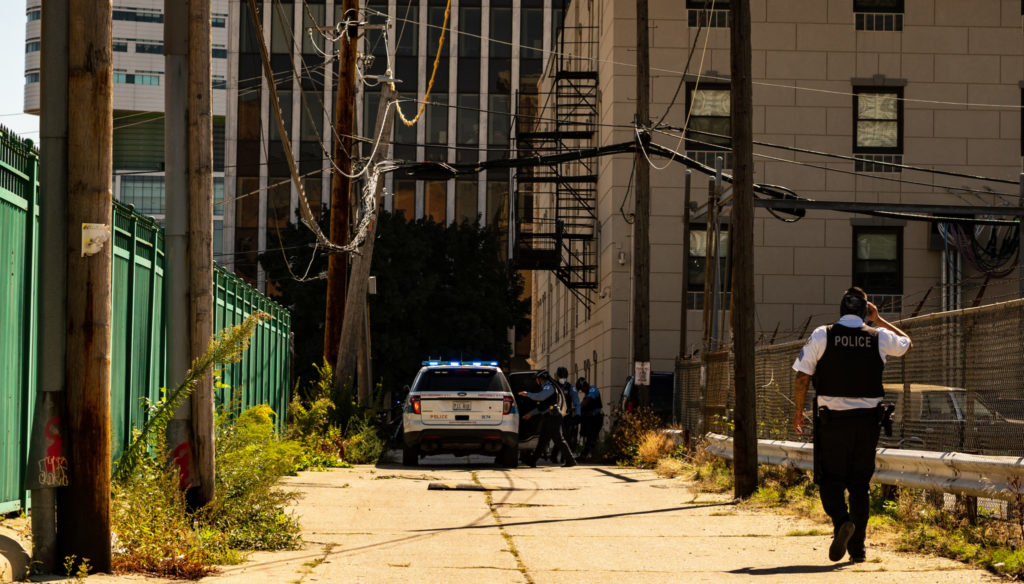
Raven Geary is a freelance writer and visual storyteller. María Maynez is a freelance journalist and community organizer based in the Southeast Side. This is each’s first story for the Weekly.

